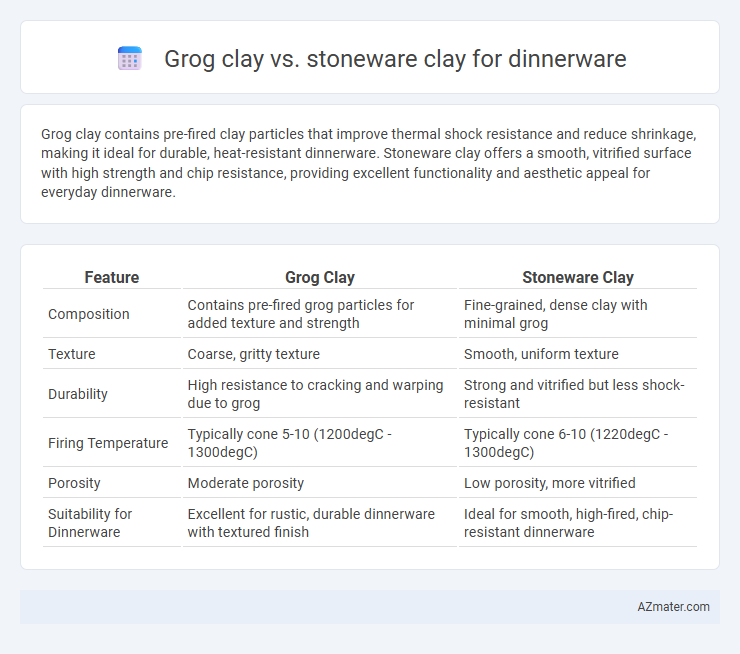Grog clay contains pre-fired clay particles that improve thermal shock resistance and reduce shrinkage, making it ideal for durable, heat-resistant dinnerware. Stoneware clay offers a smooth, vitrified surface with high strength and chip resistance, providing excellent functionality and aesthetic appeal for everyday dinnerware.
Table of Comparison
| Feature | Grog Clay | Stoneware Clay |
|---|---|---|
| Composition | Contains pre-fired grog particles for added texture and strength | Fine-grained, dense clay with minimal grog |
| Texture | Coarse, gritty texture | Smooth, uniform texture |
| Durability | High resistance to cracking and warping due to grog | Strong and vitrified but less shock-resistant |
| Firing Temperature | Typically cone 5-10 (1200degC - 1300degC) | Typically cone 6-10 (1220degC - 1300degC) |
| Porosity | Moderate porosity | Low porosity, more vitrified |
| Suitability for Dinnerware | Excellent for rustic, durable dinnerware with textured finish | Ideal for smooth, high-fired, chip-resistant dinnerware |
Introduction to Grog Clay and Stoneware Clay
Grog clay contains pre-fired and ground ceramic particles that improve thermal shock resistance and reduce shrinkage, making it ideal for durable and textured dinnerware. Stoneware clay is a dense, non-porous material fired at high temperatures, offering strong, vitrified dinnerware that is chip-resistant and suitable for everyday use. Both clays provide unique benefits: grog clay enhances structural integrity while stoneware clay delivers a smooth, sturdy finish.
Key Characteristics of Grog Clay
Grog clay contains pre-fired ceramic granules that enhance thermal shock resistance and reduce shrinkage during firing, making it ideal for durable dinnerware. Its coarse texture improves workability by preventing warping and cracking, especially in thicker pieces. The added grog also contributes to a rustic aesthetic, distinguishing it from the smoother finish of stoneware clay.
Distinct Features of Stoneware Clay
Stoneware clay features a dense, non-porous structure after firing, making it highly durable and resistant to chipping for everyday dinnerware use. Unlike grog clay, stoneware offers a smooth, vitrified surface that withstands thermal shock and retains heat well, enhancing functionality in kitchen and dining settings. Its natural color ranges from light gray to buff, providing a versatile aesthetic that blends seamlessly with various design styles.
Strength and Durability Comparison
Grog clay contains pre-fired clay particles that enhance the strength and thermal shock resistance of dinnerware, making it less prone to cracking during firing or everyday use. Stoneware clay, known for its dense and vitrified structure after firing, offers excellent durability and chip resistance, ideal for heavy-use dinnerware. Comparing both, grog clay dinnerware excels in impact resistance, while stoneware provides superior hardness and long-term durability under regular dining conditions.
Texture and Finish Differences
Grog clay contains pre-fired clay particles that create a rougher, more textured surface, providing enhanced durability and a rustic, tactile finish ideal for dinnerware with a handcrafted feel. Stoneware clay, by contrast, has a smoother texture and can be fired to a dense, vitrified finish, resulting in a sleek, non-porous surface that is highly resistant to chipping and staining. The grog in grog clay also promotes better thermal shock resistance, while stoneware offers a refined aesthetic and consistent glaze application suited for everyday dinnerware.
Suitability for Functional Dinnerware
Grog clay offers excellent thermal shock resistance and durability, making it highly suitable for functional dinnerware that encounters frequent temperature changes and handling. Stoneware clay provides a dense, non-porous surface ideal for everyday use, ensuring food safety and ease of cleaning. Both clays are robust, but grog clay's added texture enhances strength and reduces warping during firing, favoring heavier-use dinnerware applications.
Firing Temperatures and Techniques
Grog clay and stoneware clay differ significantly in firing temperatures and techniques for dinnerware production. Grog clay, embedded with pre-fired clay particles, enhances thermal shock resistance and typically fires between 1,200degC to 1,280degC, making it ideal for functional dinnerware requiring durability. Stoneware clay, known for its vitrification and strength, generally fires at temperatures from 1,100degC to 1,300degC, with precise firing schedules essential to achieve a dense, non-porous surface suitable for everyday use.
Glazing Compatibility and Results
Grog clay, containing pre-fired granular particles, enhances glaze adherence and reduces shrinkage, resulting in more stable and crack-resistant glaze surfaces for dinnerware. Stoneware clay, known for its dense and vitrified composition, allows for smooth glaze application with vibrant, durable finishes but may experience issues with glaze crawling if the surface is not properly prepared. Both clays are compatible with high-fire glazes, but grog clay often yields more textured and controlled glaze results, while stoneware clay provides sleek, glossy finishes ideal for functional dinnerware.
Advantages and Disadvantages for Artists
Grog clay offers enhanced thermal shock resistance and reduced shrinkage, making it ideal for artists seeking durability and stability in dinnerware creation, though it requires higher firing temperatures and can be rougher to work with. Stoneware clay is prized for its smooth texture, versatility in hand-building and wheel-throwing, and lower firing temperature, but it can be less resistant to chipping and thermal shock compared to grog clay. Artists must balance stoneware's ease of manipulation and finish quality against grog clay's structural advantages for functional dinnerware pieces.
Choosing the Best Clay for Dinnerware
Grog clay contains ground fired clay particles that improve thermal shock resistance, making it ideal for durable, chip-resistant dinnerware suitable for everyday use. Stoneware clay offers a vitrified, non-porous surface after firing, providing excellent strength and a smooth finish that enhances aesthetic appeal and food safety. Choosing between grog clay and stoneware clay hinges on the desired balance of texture, durability, and visual quality for functional and long-lasting dinnerware.

Infographic: Grog clay vs Stoneware clay for Dinnerware
 azmater.com
azmater.com